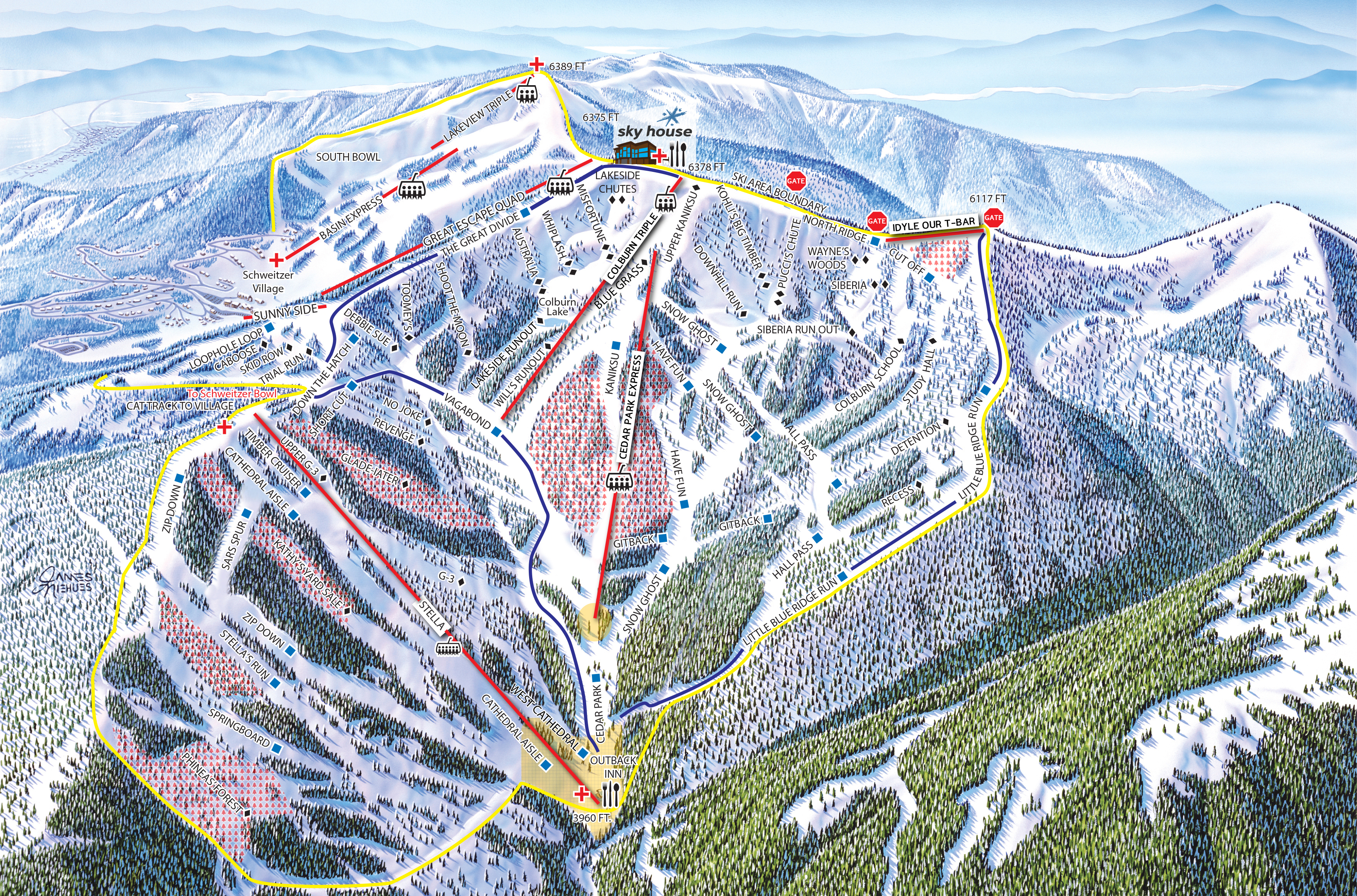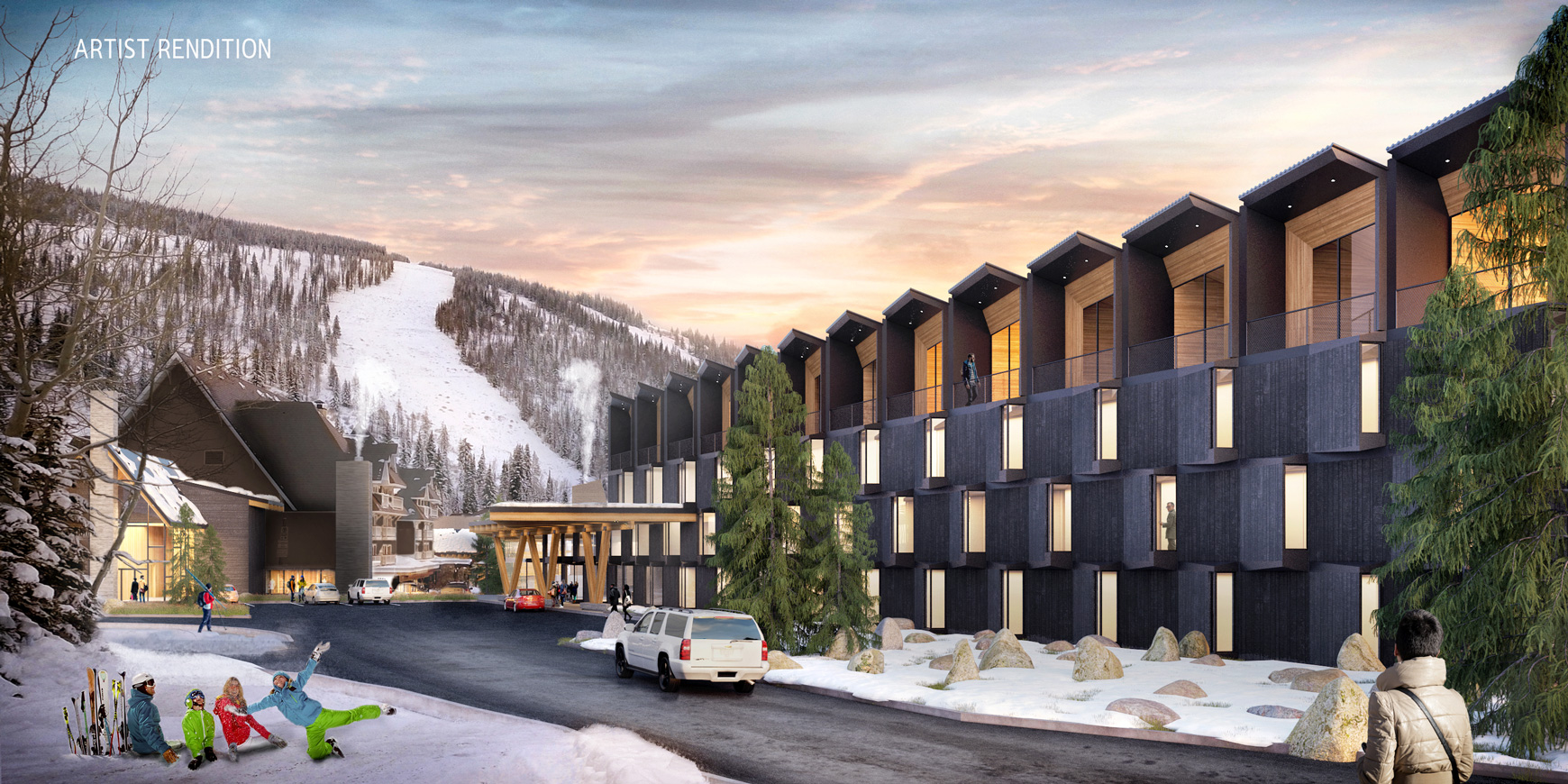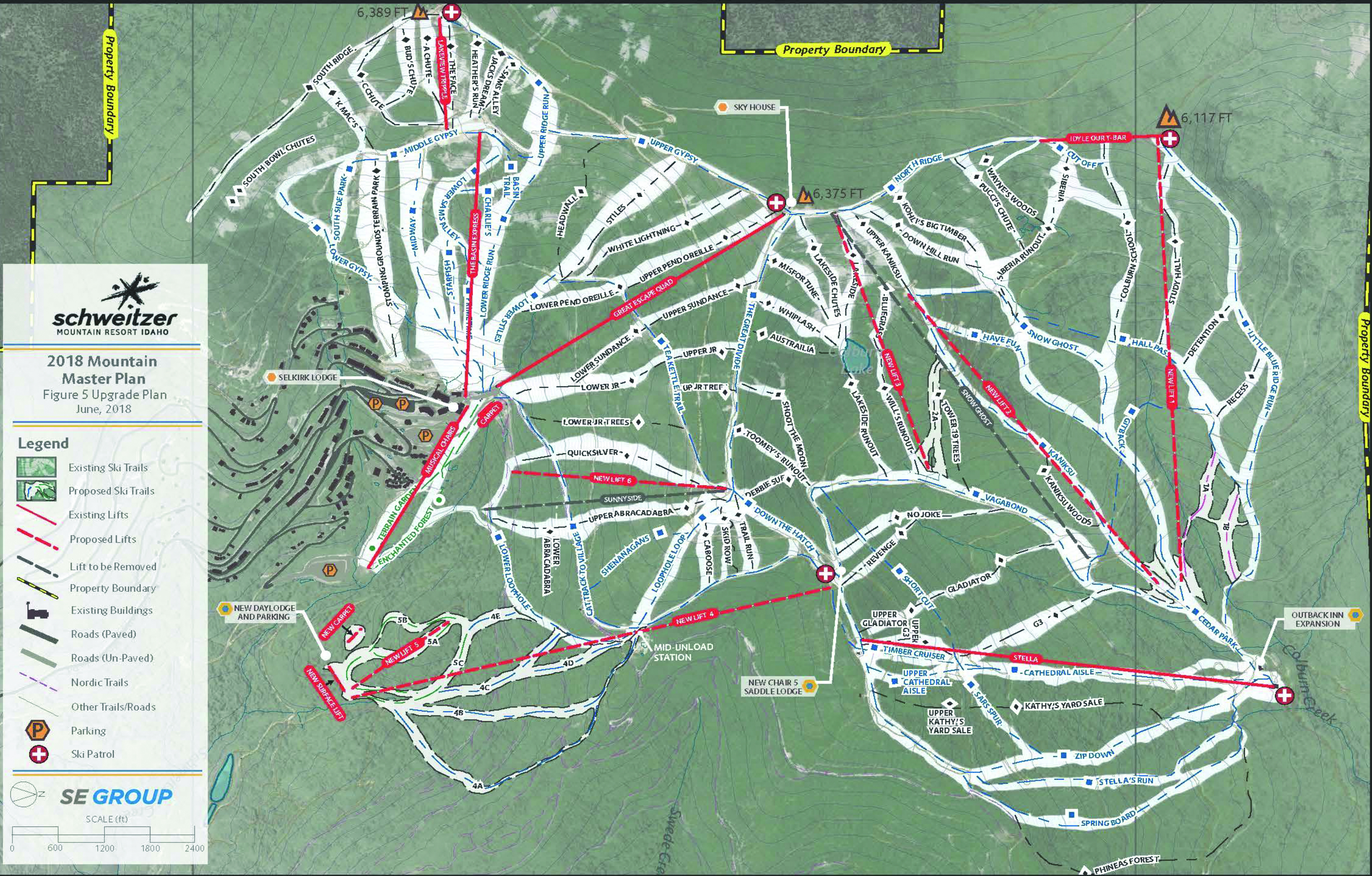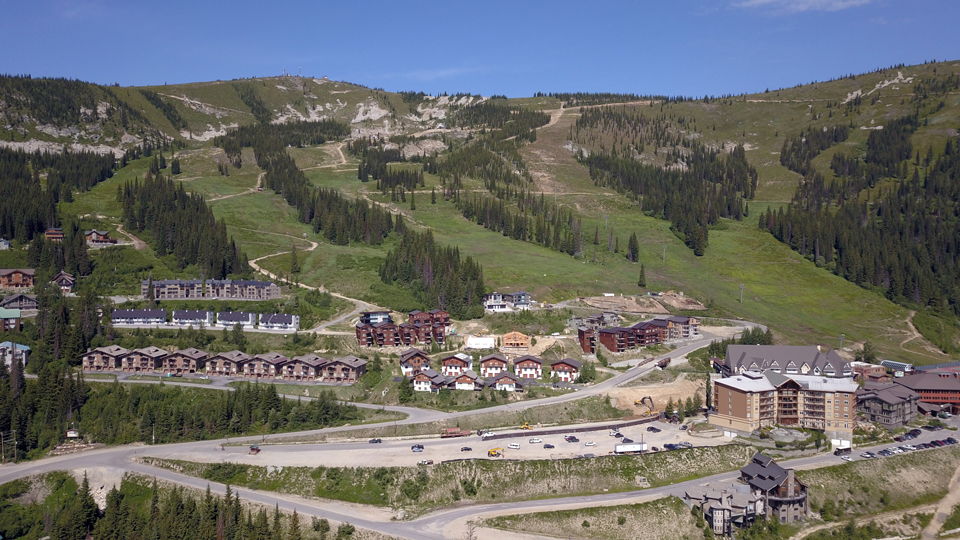Schweitzer's Master Development Plan
“Master plan – a comprehensive or far-reaching plan of action.”
Schweitzer Mountain Resort is a special place. One of the last great undiscovered resorts in North America, it provides access to a beautiful wilderness, marvelous views, family adventure and a magnificent lake.
Looking Back - October 2017
- Family
‘Adventurers’ may lead the charge in discovering a destination like Schweitzer, but its families who will populate most of the Resort. - Live/Work
At Schweitzer, work-life balance takes on special meaning. The resort itself is a symbol of how people can achieve more balance in their lives. But for many visitors, because Schweitzer is more a three-or-four-day weekend than a two-day weekend, Schweitzer Mountain Resort needs to get much tech-savvier and fast. - Food and Beverage
Americans have become foodies. Not just in the cities, but everywhere. Schweitzer needs to capitalize on this interest and support the growth of a culture that embraces great local foods and cooking. - Health/Wellness/Sustainability
These topics need to become core values and at the heart of all decisions made on the mountain. - Summer
It’s been said that “summer drives winter” in creating successful all-season mountain resorts. The more immersive those summer experiences can be, and the more they connect the mountain with the town and the lake, the more Schweitzer, and the community of Sandpoint, benefits. - Skiing
Mountain improvements with upgraded lifts, new terrain and expanded services need to develop in parallel with business growth.
Moving Forward
Since the 2017 Sky House gathering, Schweitzer has been growing rapidly. The resort has seen record skier visits in the last two years and its reputation as the best family friendly resort in the Pacific Northwest is reverberating with many who are searching out more authentic ski and snowboard experiences. With this growth, there have been some challenges – strains on the existing infrastructure, the need for more beginner terrain, and more lodging accommodations for visitors on the weekends. Identifying key areas that need improvement has been a relatively easy task, but developing a strategy to tackle these challenges becomes critical. Yes, Schweitzer is growing and so the question becomes, how does the 16th largest ski area in the US work towards a sustainable future that keeps it moving forward without changing the heart of what customers love about Schweitzer?
This question isn’t new. Since the resort first began in 1963, there have been plans to upgrade and improve the overall experience both on and off the slopes. “The resort, from its inception, has always been looking forward, searching for ways to improve and grow,” explains Schweitzer CEO Tom Chasse.
The newest master plan for Schweitzer was developed thanks to that October 2017 meeting and culminated with the Board of Directors engaging with SE Group, a company whose focus is on strategy, permitting, planning and design for communities, ski resorts, educational institutions, real estate development and public land management groups. Throughout the process, it was SE Group’s role to analyze and look into every aspect of the overall guest experience at Schweitzer. They took into account details like the exact number of hotel beds, parking spaces and lift capacity numbers, how many tables are in the restaurants, and even the number of toilets available on the mountain. They worked closely with the director team to understand how Schweitzer functions during day to day operations and what areas were facing new challenges. With no stone left unturned and studied, the latest master plan for Schweitzer was finalized, laying out three phases of growth over the next 15 years.
Phase One of the Master Plan

The first part of Schweitzer’s master plan was launched quickly in the spring of 2019 with the replacement of the Snow Ghost double chair serving the Outback and North bowls on the mountain. “Something we need to remember when it comes to acting on our master plan is Schweitzer’s unique situation as a private land owner,” adds Chasse. “We own all the land therefore it makes the whole process much faster. From a regulatory stand point, we don’t need to request permission from the Forest Service to move forward with projects. That's why we were able to install the new lifts as quickly as we did.”
Snow Ghost was replaced with two new lifts – the Cedar Park Express and the Colburn Triple. The Cedar Park Express quad chair starts just above the Cedar Park run and terminates at approximately the same location of the former mid-unload of Snow Ghost. This new lift provides more access to several underutilized runs like Have Fun and Snow Ghost. “The two lift configuration helps us split up our skier user groups,” explains Mountain Operations Director Rob Batchelder. “The new quad offers easier access to blue, intermediate terrain and the Colburn Triple gets us right back to the steep stuff in Lakeside Chutes. During the lift construction process, we logged approximately 300 acres and created new runs for our guests to enjoy in the North Bowl and we are pretty proud of that.”
Press Release (Oct 24, 2018) - Schweitzer Contracts Installation of Two New Lifts for 2019/20
Phase Two of the Master Plan

Schweitzer finalized plans and broke ground on an additional 30 unit boutique hotel in the village. “The Board of Directors is motivated to find a solution for our lack of accommodations on the mountain,” says Chasse. “It’s challenging at best to find a room over weekends and holidays so the additional units will help ease that lodging crunch.” Schweitzer started the surveying process, relocation of utilities, and excavation of the underground parking in June of 2019 with a planned delivery during the 20/21 season. “Again, thanks to owning our own land, we can move forward with this project as quickly as permitting and financing allow.”
The as yet unnamed hotel is designed by the Portland based firm Skylab Architecture. “Drawing on the heritage of Schweitzer Basin, yet contemporary in its design, it will provide a perfect venue for guests to relax, play and revel in the natural beauty surrounding them,” says Jeff Kovel, Principal/Design Director at Skylab. “Guests will enjoy spaces that heighten their connection to the outdoors and the rich local history. The building will be a state of the art facility and feature heavy timber construction (CLT) but also reuse materials (like chairlift cables) from around the Resort.”
In concert with the development of the hotel, Schweitzer and Skylab have partnered with Dunn + Kiley, a master planning and landscape architecture firm that is internationally recognized for its expertise in the planning and design of mountain resorts. Dunn + Kiley will be instrumental in improving the landscape architecture surrounding the hotel and within the existing village.
Press Release (July 9, 2019) - Schweitzer Announces Construction of New 30 Unit Boutique Hotel
Phase Three of the Master Plan

The third phase of Schweitzer’s master plan is arguably the most unique from any other plan put forward for the resort. “Growth has been huge the last few years and we need to find solutions for our parking issues and ease the burden on our existing village,” Batchelder comments. “Honestly, I’m very excited about solving those problems with this third phase of development in the Mid-Mountain area.”
Mid-Mountain would be a dedicated day-skier area, perfect for beginner and intermediate skiers and riders, with ample parking for day visitors and additional rental and ski school facilities. “Right now, we have a gap in offering enough beginner and intermediate terrain,” continues Batchelder. “Mid-Mountain will create approximately 8 new runs with new lifts and an additional carpet which will cater directly to those new skiers.” Batchelder also points out that one of the proposed lifts from the Mid-Mountain area would connect to the saddle area between Down the Hatch and the Stella off-load making it possible to head straight to the backside of the mountain without needing to pass through the main village or ride the Great Escape quad. “Physically, we need room to grow and Mid-Mountain does that for us.”
The resort also has another lift expansion project in this phase with the addition of a lift from the Cedar Park area to the summit of Little Blue. “Our skiers and riders enjoy skiing the far northern boundary of the resort and a lift serving that location will make access so much easier,” explains Chasse.
As with any development or planning on this scale, there are several factors that can play into the timeline in which the plan will be completed. “We have a pretty conservative approach,” notes Chasse. “Our business is growing but we want to make sure that we are financially sound and don’t get ahead of ourselves. We also want to maintain a razor sharp focus on improving the overall customer experience with everything that we do.”
Schweitzer expects this master plan to reach full completion in 7 to 15 years as long as business levels continue to grow as predicted. “During my tenure at Schweitzer, we’ve replaced Chair 1 by adding 2 new lifts, enhanced our snowmaking capacities, built Sky House and added 2 new lifts in the North Bowl,” reminisces Chasse. “I really feel we have achieved everything we can to be competitive. The goal is to make Schweitzer a true destination ski resort with some national recognition and that’s happening. We think this master plan will help us achieve our goal to provide the best skiing and snowboarding experience around.”
Real Estate Development

Unlike most other ski resorts in the Western US, Schweitzer Mountain Resort is not on National Forest Service Land. It is not owned by “the government” and leased to a licensed private operator. It is owned and operated privately, with just under 7,000 acres of total property.
Schweitzer’s "fee simple" ownership means there is strong upside potential for developing second residences and top of the market amenities on the mountain. In fact, Schweitzer also enjoys a unique ability to build on the mountain top, providing experiences most other ski resorts simply can’t contemplate. This is a huge advantage - owning the land you operate on can make any vision of unlocking the true potential of a property much more real, much sooner.
The most recent 35 unit subdivision, MountainSide, has nearly sold through and Schweitzer is working on plans for future subdivisions and other real estate offerings. Within the current Planned Unit Development (PUD), there are over 7,000 units of density - of which, roughly 10% have been developed.
"With the new hotel, proposed new lifts, and our expansive opportunity for real estate development, I’m very excited about this master plan and the future of Schweitzer" concludes Chasse.




